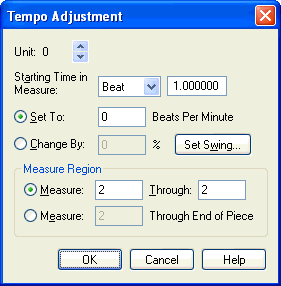|
L'aide française est disponible au format PDF en cliquant ici (ou dans le Menu "Démarrer", Finale 2010, Documentation PDF française)
Le tutoriel français est disponible au format PDF en cliquant ici.
La mise à jour de l'aide française au format HTML sera disponible prochainement.
|
Traduction française :

|
Tempo Adjustment dialog box

How to get there
From the Window menu, choose Advanced Tools. Click the Tempo Tool  , and click a measure.
, and click a measure.
What it does
The Tempo Tool lets you edit tiny, moment-by-moment tempo fluctuations within the playback of a piece. You’ll rarely need to know about the fairly technical concept of the Tempo Tool; nonetheless, you can use it to create certain unique temporal effects.
You can use it, for example, to create a swing effect, although the Playback Controls provide a much more efficient and effective method of creating swing.
In the Tempo Adjustment dialog box, "beats" refers to the beat in the current time signature, rather than assuming a quarter note is the beat. The measure range defaults to this measure only (instead of through the end of the piece). Most tempo adjustments, except for "swing", should be placed only at the beginning of the area they are supposed to affect.
Tempo data is what you "capture" in Transcription Mode from your real-time performance (by clicking Save Tempo) so that Finale can recreate your tempo changes when it plays back the transcription. In this dialog box, however, you can directly edit the Tempo data for the measure you clicked.
- Unit (#). You can change the tempo as many times as you want within a single measure. Each tempo change is called a Unit; this indicator specifies the Unit whose data is displayed in the dialog box. Scroll among the Units you’ve created by clicking the small up and down arrow buttons.
- Starting Time in Measure: Beat • EDUs. This drop-down list and text box allow you to specify the precise moment in the measure where you want the tempo to change. You can enter any beat or value, even one that corresponds to a point in the measure where no note is being struck. For example, in a 4/4 measure (even an empty one), you can specify a tempo change on the third beat by setting these controls to say Beat 3.

- Set to ___ Beats Per Minute. Click this option if you want Finale to store each tiny tempo change as an absolute tempo change. In other words, Finale might think to itself, over the course of a single measure: "60 beats per minute… 65… 70." This is the most precise method of tempo programming. Enter the metronomic tempo marking in the text box (120, for example, for 120 beats per minute).
- Change by ___ %. Use this option if you want Finale to establish a new tempo as a percentage of the tempo that preceded it. In other words, Finale might think to itself: "60 beats per minute... 8% faster than that... 10% faster than that." Enter the amount of tempo change into the text box. While this kind of tempo change is slightly less precise than the Set To kind, it lets you change the starting tempo (with an expression, for example), while still preserving the relative tempo changes over the course of the piece.
- Set Swing. Click this button to display the Set Swing dialog box, where you can specify a degree of swing for the measures. For standard triplet-feel, eighth-note swing, just click OK. (See Set Swing Ratio dialog box.)
- Measure ___ Through ___ • Measure ___ Through End of Piece. Using these controls, specify what range of measures you want to affect with this tempo change. The change you specified will be repeated in each measure of the range.
- OK • Cancel. Click OK to confirm, or Cancel to discard, your tempo settings and return to the score.
See Also:
Tempo Tool
Set Swing Ratio




